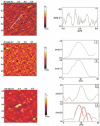Controlled loading of oligodeoxyribonucleotide monolayers onto unoxidized crystalline silicon; fluorescence-based determination of the surface coverage and of the hybridization efficiency; parallel imaging of the process by Atomic Force Microscopy
- PMID: 16507670
- PMCID: PMC1385995
- DOI: 10.1093/nar/gnj034
Controlled loading of oligodeoxyribonucleotide monolayers onto unoxidized crystalline silicon; fluorescence-based determination of the surface coverage and of the hybridization efficiency; parallel imaging of the process by Atomic Force Microscopy
Abstract
Unoxidized crystalline silicon, characterized by high purity, high homogeneity, sturdiness and an atomically flat surface, offers many advantages for the construction of electronic miniaturized biosensor arrays upon attachment of biomolecules (DNA, proteins or small organic compounds). This allows to study the incidence of molecular interactions through the simultaneous analysis, within a single experiment, of a number of samples containing small quantities of potential targets, in the presence of thousands of variables. A simple, accurate and robust methodology was established and is here presented, for the assembling of DNA sensors on the unoxidized, crystalline Si(100) surface, by loading controlled amounts of a monolayer DNA-probe through a two-step procedure. At first a monolayer of a spacer molecule, such as 10-undecynoic acid, was deposited, under optimized conditions, via controlled cathodic electrografting, then a synthetic DNA-probe was anchored to it, through amidation in aqueous solution. The surface coverage of several DNA-probes and the control of their efficiency in recognizing a complementary target-DNA upon hybridization were evaluated by fluorescence measurements. The whole process was also monitored in parallel by Atomic Force Microscopy (AFM).
Figures









Similar articles
-
Probing DNA hybridization in homogeneous solution and at interfaces via measurement of the intrinsic fluorescence decay time of a single label.J Fluoresc. 2008 Mar;18(2):413-21. doi: 10.1007/s10895-007-0281-2. Epub 2007 Dec 19. J Fluoresc. 2008. PMID: 18092141
-
Monitoring molecular beacon DNA probe hybridization at the single-molecule level.Chemistry. 2003 Nov 21;9(22):5686-92. doi: 10.1002/chem.200304977. Chemistry. 2003. PMID: 14639652
-
Non-covalent monolayer-piercing anchoring of lipophilic nucleic acids: preparation, characterization, and sensing applications.J Am Chem Soc. 2012 Jan 11;134(1):280-92. doi: 10.1021/ja206639d. Epub 2011 Dec 12. J Am Chem Soc. 2012. PMID: 22084968
-
Real-time assays with molecular beacons and other fluorescent nucleic acid hybridization probes.Clin Chim Acta. 2006 Jan;363(1-2):48-60. doi: 10.1016/j.cccn.2005.04.037. Epub 2005 Aug 18. Clin Chim Acta. 2006. PMID: 16111667 Review.
-
Molecular beacons: a novel DNA probe for nucleic acid and protein studies.Chemistry. 2000 Apr 3;6(7):1107-11. doi: 10.1002/(sici)1521-3765(20000403)6:7<1107::aid-chem1107>3.3.co;2-0. Chemistry. 2000. PMID: 10785794 Review.
Cited by
-
Graphene for the Building of Electroanalytical Enzyme-Based Biosensors. Application to the Inhibitory Detection of Emerging Pollutants.Nanomaterials (Basel). 2021 Aug 18;11(8):2094. doi: 10.3390/nano11082094. Nanomaterials (Basel). 2021. PMID: 34443924 Free PMC article.
-
Controlling oligonucleotide surface density in light-directed DNA array fabrication.Langmuir. 2009 Jun 2;25(11):6570-5. doi: 10.1021/la9000297. Langmuir. 2009. PMID: 19281155 Free PMC article.
References
-
- Ball P. Silicon still supreme. Nature Mater. 2005;4:119. - PubMed
-
- Hersam M.C., Guisinger N.P., Lydin J.W. Silicon-based molecular nanotechnology. Nanotechnology. 2000;11:70–76.
-
- Yin H.B., Brown T., Greef R., Wilkinson J.S., J.Melvin J. Chemical modification and micropatterning of Si(100) with oligonucleotides. Microelectronic Eng. 2004;73–74:830–836.
-
- Herne T.M., Tarlov M.J. Characterization of DNA probes immobilized on gold surfaces. J. Am. Chem. Soc. 1997;119:8916–8920.
-
- Peterlinz K.A., R.M.Georgiadis R.M. Observation of hybridisation and dehybridisation of thiol-tethered DNA using two-color surface plasmon resonance spectroscopy. J. Am. Chem. Soc. 1997;119:3401–3402.
Publication types
MeSH terms
Substances
LinkOut - more resources
Full Text Sources
Miscellaneous

